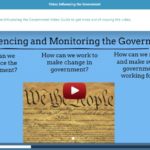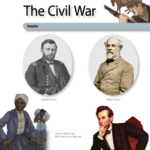This Teacher’s Guide provides information and resources for integrating creative approaches to place-based history in K-12 humanities education. As tangible reminders of the past, memorials and monuments, as well as neighborhoods, historic homes, waterways, and many other sites, have the power to influence how we interpret contemporary society. The resources herein address public history and the disciplines that fall within the field; NEH Landmarks of American History and Culture programs and the resources that have been developed for educators; and access to sites included in the National Register of Historic Places and National Historic Landmarks. By introducing historic and cultural sites into the classroom setting, students can develop a greater understanding of the reality and prevalence of history in their local landscape.
Campaign Finance
Students can hear Sal give an introduction to campaign finance up to and after Citizens United, including the difference between soft and hard money, the influence of PACs and super PACs, and the impact of the McCain-Feingold Act. They can then follow that up with an in-depth video on Citizens United v. FEC in which Sal discusses the background and holdings of the case with scholars Richard Hasen, professor of law at UC Irvine School of Law, and Bradley Smith, former chairman of the FEC. Teachers can then assign an exercise to their students aligned to the current AP Government and Politics exam to assess how well they understood the content of the lesson.
Comparing the Magna Carta and English Bill of Rights with the U.S. Bill of Rights
In this activity students will examine the influences of the Magna Carta and the English Bill of Rights on the Bill of Rights in the U.S. Constitution. By the end of the activity students should be able to cite clear examples of the influence of English legal traditions in the U.S. Bill of Rights; they should also be able to give examples of how the American document is unique in offering even further expanded rights.
Native American Cultures Across the U.S.
Teaching children about the First Americans in an accurate historical context while emphasizing their continuing presence and influence within the United States is important for developing a national and individual respect for the diverse American Indian peoples, and is necessary to understanding the history of this country.
How Do We the People Influence and Monitor the Government?

This resource provides students with an English language video and associated student friendly readings (in English, Spanish, and Haitian Creole), as well as reading and video guides and self assessment tools. Using these, students will consider the different ways that citizens, interest groups, and the media can influence and monitor government.
Free registration is required to use the resource.
Individuals Influence Public Policy
In this lesson, students are presented with a controversial school policy and given two viewpoints on the issue. They are then divided into groups, and asked to provide reasons for and against the policy. After deciding whether the policy should be changed or not, the students are asked to reflect on why policies might change and what factors influence policy decisions.
The Influence of the Declaration of Independence on the Constitution
In this lesson, students will use C-SPAN video clips to examine the founding principles that emerged from the Constitutional Convention as well as hear about some of the people who participated. Students will use this information to analyze the role the compromise played in the creation of the Constitution.
The Civil War (CKHG Unit)

This unit explores the political, historical and cultural causes and consequences before, during and after the Civil War, one of our nation’s greatest crises. Across 24 lessons, students engage with the material through primary sources and consider the influence of abolitionists and other intellectual as well as military and political figures.
This unit includes 24 lessons that are about 45 minutes each.
Magna Carta: Introduction
Learn about the significance and influence of Magna Carta on U.S. history and government in this video from the ABOTA Foundation and PBS Learning Media. Includes video, background essay, guide for teachers, and teaching tips!
The Constitutional Convention: Slavery and the Constitution
History is the chronicle of choices made by actors/agents/protagonists in specific contexts. This simulation places students at the Constitutional Convention and asks them to engage in the most problematic issue the framers faced: how to deal with slavery. Although most delegates believed slavery was deplorable, it was so deeply entrenched that any attempt to abolish it would likely keep several states from approving the proposed Constitution. By confronting this issue, students will experience for themselves the influence of socioeconomic factors in the political arena, and they will see how political discourse is shaped by arguments based on morality, interest, and pragmatic considerations, often intertwined.